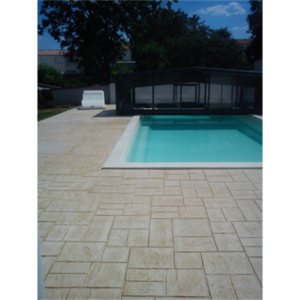Installing Stamped Concrete
There are many benefits of Stamped Concrete. First, this surface type mimics real materials. This means that no one will mistake it for real stone or wood. Furthermore, it requires less maintenance than other materials and has a longer lifespan. Stamped concrete can be used anywhere in your home, which is a plus for anyone who has small children. However, you should be aware of the cost involved in installing Stamped Concrete.

A release agent is applied to the surface of the concrete before stamping. This release agent prevents the stamp from sticking and offers an accent color to the concrete. Ideally, a darker release agent is used over a lighter base color. Once the release agent is applied, the stamping process begins. The stamping tools are pressed into the concrete surface, creating a texture. The colored release agent then embeds itself into the textured surface of the concrete.
Other options for stamped concrete include brick, cobblestone, and wood patterns. These designs can be applied to both existing concrete floors and walls. In addition to creating attractive floor surfaces, stamped concrete can also be used to imprint patterns on countertops. There are numerous pattern options for Stamped Concrete, so you can design the floor of any room in your home, from the kitchen to the bathroom. You can choose between a variety of patterns to fit your tastes and aesthetics.
The installation process of Stamped Concrete should be done carefully, as any mistakes could result in a distorted texture. It is important to follow all of the steps to ensure the durability and look of your new flooring. If you have an older house, you can even stamp the existing concrete slab to give it a new look. It is not necessary to redo your entire home to install Stamped Concrete, but it will make your property look more stylish.
The process of Stamped Concrete starts with a layer of cement. The cement is mixed with a color release agent to add dimension. You can apply the texturizing mats to the cement while it is still wet. To make the most of this material, you should make sure you line up the texturing mats as carefully as possible. Then, wait for the cement to dry for 24 hours before pressure washing it. Afterwards, you can remove the release agent and enjoy your new stamped concrete surface!
Despite the fact that Stamped Concrete requires little maintenance, it should still be kept clean. Avoid using acidic cleaners on it, as these can cause delamination. Instead, use water and mild detergent to clean your Stamped Concrete. If your pool deck has Stamped Concrete, be sure to drain excess water to avoid algae growth. Moreover, you should always be cautious of hot tires as they may damage the surface.
Stamped Concrete can be durable and look similar to wood, stone, brick, tile, or even wood. If you are going to use Stamped Concrete on a driveway, make sure that the surface is level. Make sure that the area is free of debris and graded properly. Then, pour the mix on top of the base. Make sure you follow the manufacturer’s instructions for your Stamped Concrete. The strength and color of your concrete will depend on the mix you use.
Stamped Concrete is one of the most versatile and cost-effective ways to transform your home. You can create a variety of patterns on Stamped Concrete by using stamps on concrete. The most common ones are brick, tile, and stone. This technique can also be used for pool decks, driveways, and patios. It is a durable, affordable option for landscaping, and is also a good choice for driveways, pool decks, and patios. Stamped Concrete is a low-cost alternative to expensive building materials, and it can add a great deal to the curb appeal of your home.
However, there are some disadvantages to Stamped Concrete as well. Installing a stamped concrete driveway or pool deck is a complex task that requires many steps, including leveling the area and fitting stones together. However, it is worth the cost because it can add thousands of dollars to the value of your home. Furthermore, some stamps may make the concrete appear more textured than usual, and this can make it more slippery in the rain. To avoid this issue, consider adding a non-slip additive to the concrete.
